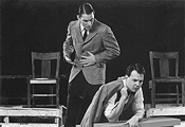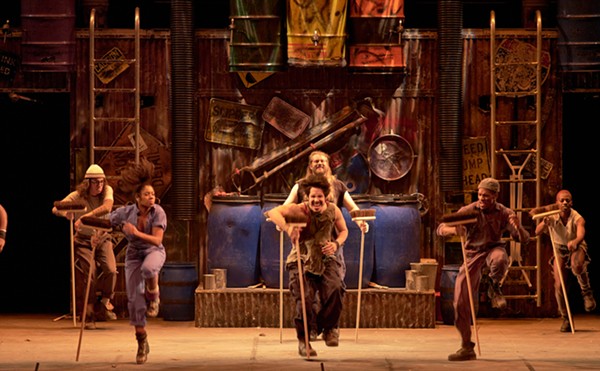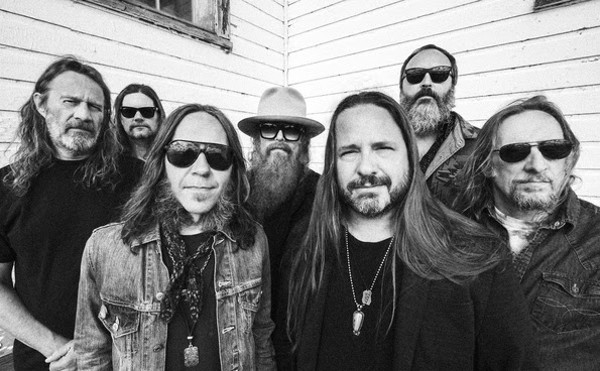This sock-in-the-solar-plexus play by John Logan is the stage equivalent of a juicy B-movie. Hypnotic as a Hindu snake charmer is this prismatic exploration of the Leopold-Loeb murder case, the first-publicized thrill killing -- a scandal that, along with Sacco/Vanzetti, the Lindbergh flight, and Prohibition, defined the Jazz Age as a madcap spree ending in the excruciating hangover of the Depression.
In the last few years, director Joel Hammer has had a burgeoning 24-karat career; his name on a program has become the hallmark of dependability and quality. He has the shrewd majesty of one of those long-ago Hollywood pros (usually with a thick German accent) who infallibly knew how to negotiate the most intriguing scripts and impeccable casts. One can visualize Hammer maniacally chomping on a cigar, using his megaphone to amplify a cutting witticism, and telling his leading man to "shaddup" all the while romancing the most luscious peach on Hollywood and Vine. Hammer manages to conceive bold stage images destined to sear the brains of generations of enthralled audiences.
Playwright Logan has taken a legendary American nightmare of narcissism that leads to murder as ego trip -- a tale already treated by Alfred Hitchcock in his film Rope and Meyer Levin in the novel and film Compulsion -- and redesigned it as a staged film noir. It brings to mind a Picasso landscape of skewed perspective, with pieces of piety, murder, and mayhem memorializing the birth of 20th-century celebrity culture.
The central image that permeates this very real nightmare is that of two young lads in Ivy League collegiate finery, locked in each other's arms in a dance to the melancholy strains of Irving Berlin's What'll I Do? One of the youths, Nathan Leopold Jr., is enacted with a plaintive creepiness by Doug Rossi as a slightly puffy, heavy-lidded loner with too much intelligence for his own good. He's what would have been referred to at the time as a neurotic "pansy" in desperate need. In his hungry arms, a gauntly handsome, spoiled rich boy, Richard Loeb, is played by Jason Markouc as a demonized Horatio Alger protagonist. Underneath his slicked-down Valentino hair and handsome ferret face beats the heart of a Jabberwock, lusting for a partner in perfidy, willing to barter sexual favors in exchange for enslavement. They kiss, causing poisonous combustion: two half-souls melded into one monster.
On a courtroom set that reminds us of an operating theater in a medical school, the two maniacal schemers plan and envision foul deeds while whistling like a couple of satanic Jiminy Crickets. Between arrogant smirks and tawdry kisses, they plan a murder as if it were an arts-and-crafts project. They bolster each other's resolve and calmly decide on the perfect victim. ("How about your brother?" "No, it might upset Mom.")
In a memorable directing flourish, Hammer stages a horrific dumb-show under hellish lights, as the boys pantomime their dreams of being Nietszchean supermen as they beat the unseen, helpless Bobby Franks to death.
After the murder, we head down a dark Nabokovian street, as Loeb becomes an overnight heartthrob, receiving fan mail in prison ("You have the dreamiest eyes."). He dreams of a career in pictures, where he can "pitch the woo to Mary Pickford."
Up to this point, we have been spectators of a chilling black comedy. Yet, in the last third of the play, Bernard Canapari's Clarence Darrow comes to the fore. The world-famous defense attorney's courtroom plea for justice and compassion in saving the boys' lives has the combined eloquence and fire of George C. Scott and Lee J. Cobb. A glimmer of moral recognition has penetrated the amoral carcasses of the killers, and they begin to realize the torments of remorse as their metaphysical facades begin to crumble.
By evening's end, we have been carried away by an emotional twister spun by the skill of experts who have blown our keisters over the rainbow. This is a joyride only chuckleheads would dare to forgo.
Never the Sinner, through January 30 at the Jewish Community Center's Halle Theatre, 3505 Mayfield Road, Cleveland Heights. 216-382-4000.
August Strindberg called A Dream Play his "most beloved drama, the child of my greatest suffering." If he could see the present Cleveland Play House production of it, he would indeed suffer. This allegory, about an Indian god's willful daughter's vacation spree on planet Earth, is credited with liberating drama from the chains of the drawing room to wondrous flights of expressionism.
Gerry Bamman and Irene B. Berman's earthbound translation renders it a rhapsody in whining. Director/designer Pavel Dobrusky begins with a plastic shower curtain with "God" embroidered on it and culminates with an unappealing girl-child rolling a hula hoop to milk applause. In between, a gaggle of enslaved actors lug about the stage a gigantic chair, much like the Hebrew slaves under Pharaoh. The only performer to emerge from the blur with any credibility or dignity is Andrew May, due to a force of personality that refuses to be buried in the mire.












